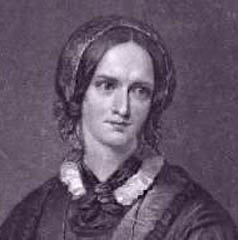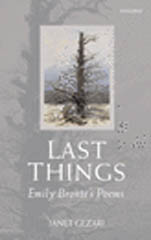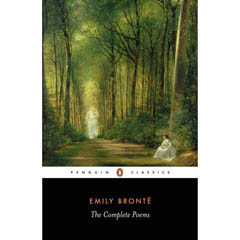Beyond Gondalisation
 It is undoubtedly true that Emily Brontë’s poems are more known about than read. When twenty-one of her poems were first published under the pseudonym Ellis Bell in 1846, in a small volume alongside work by Currer and Acton Bell, the publication attracted three reviews. The anonymous reviewer in the Athenaeum presciently opined that of these ‘three brothers’, it is the poems of Ellis that have ‘an evident power of wing that may reach heights not here attempted’ and which ‘convey an impression of originality beyond what his contributions to these volumes embody.’ Of the print-run of one thousand copies, only two copies were sold in the first year, the remainder were eventually transferred by the publisher Aylott and Jones to Smith, Elder. Within two years of publication of Poems by Currer, Ellis and Acton Bell, and the year after achieving her great masterpiece Wuthering Heights, Emily Brontë was dead. Hers has been entirely a posthumous reputation.
It is undoubtedly true that Emily Brontë’s poems are more known about than read. When twenty-one of her poems were first published under the pseudonym Ellis Bell in 1846, in a small volume alongside work by Currer and Acton Bell, the publication attracted three reviews. The anonymous reviewer in the Athenaeum presciently opined that of these ‘three brothers’, it is the poems of Ellis that have ‘an evident power of wing that may reach heights not here attempted’ and which ‘convey an impression of originality beyond what his contributions to these volumes embody.’ Of the print-run of one thousand copies, only two copies were sold in the first year, the remainder were eventually transferred by the publisher Aylott and Jones to Smith, Elder. Within two years of publication of Poems by Currer, Ellis and Acton Bell, and the year after achieving her great masterpiece Wuthering Heights, Emily Brontë was dead. Hers has been entirely a posthumous reputation.
Since her death more than a century and a half ago, Emily Bront
ë’s poems have inhabited a kind of half-world. Various reasons may account for this. According to Janet Gezari, one reason for some of the long-standing neglect visited upon Bront
ë’s poems can be attributed to ‘the idea of Victorian poetry as largely a male preserve with only small spaces carved out for Emily Brontë, Elizabeth Barrett Browning, and Christina Rossetti.’ But she also argues that feminist criticism, while ‘challeng[ing] that understanding of Victorian poetry has also brought expectations of its own to the poetry of Victorian women and that these expectations ‘threaten to make Brontë inconsiderable once again.’ Referring to recent critical writings, Gezari writes, ‘unlike Barrett Browning, Brontë wrote no poems that campaign for changes in the lives of women and the opportunities available to them; unlike Rossetti, she doesn’t explore feminine subjectivity and female sexuality in her poems, or doesn’t do so in a vocabulary yet familiar to us.’  Part of this neglect may also be traced back to what Charlotte Brontë was to write in her peculiar Biographical Notice of Ellis and Currer Bell in 1850, that her sister’s poems ‘were not common effusions, nor at all like the poetry women generally write. I thought them condensed and terse, vigorous and genuine. To my ear, they had also a peculiar music – melancholy, and elevating.’ From this Gezari extrapolates, ‘if the value of Emily Brontë’s poetry was not apparent in relation to the interests of critics of canonical Victorian poetry before the birth of modern feminist scholarship and theory, its value is no more apparent in relation to the interests that feminist critics are currently supplying to guide our reading.’ And to conclude this line of argument, Gezari adds, ‘recent feminist criticism endorses Charlotte Brontë’s judgement that no woman ever wrote poems like those her sister was writing, and this judgement may provide what she – Charlotte Brontë – couldn’t have anticipated: an additional reason for not paying them any mind.’
Part of this neglect may also be traced back to what Charlotte Brontë was to write in her peculiar Biographical Notice of Ellis and Currer Bell in 1850, that her sister’s poems ‘were not common effusions, nor at all like the poetry women generally write. I thought them condensed and terse, vigorous and genuine. To my ear, they had also a peculiar music – melancholy, and elevating.’ From this Gezari extrapolates, ‘if the value of Emily Brontë’s poetry was not apparent in relation to the interests of critics of canonical Victorian poetry before the birth of modern feminist scholarship and theory, its value is no more apparent in relation to the interests that feminist critics are currently supplying to guide our reading.’ And to conclude this line of argument, Gezari adds, ‘recent feminist criticism endorses Charlotte Brontë’s judgement that no woman ever wrote poems like those her sister was writing, and this judgement may provide what she – Charlotte Brontë – couldn’t have anticipated: an additional reason for not paying them any mind.’
Another reason that may account for the neglect of Emily Bront
ë’s poetry is the tendency of critics towards ‘gondalisation’, a tendency which has not diminished over time. While a good many – but certainly by no means all of her poems – may belong to the Gondal saga that she and Anne created, looking to the world of Gondal may be helpful when trying to establish the likely date of composition of a lyric or fragment, or to elucidate meaning from such a piece, but where critics have attempted – and continue – to see her work in poetry purely in terms of ‘G’ and ‘non-G’, the division is not always satisfactory. In her discussion of the poems, Gezari ‘does not ignore the presence of Gondal in the poems
…but resist[s] dividing those that belong to a Gondal narrative from those that probably do not.’ She notes that ‘a specious distinction between Gondal and personal narrative contexts continues to thrive, especially when biographical interpretations are at stake. Believing that a Gondal poem is less personal than a non-Gondal poem is like believing that The Bell Jar is less personal than ‘Daddy.
 The title of Gezari’s study – Last Things – ‘registers her starting place.’ She writes, ‘a concern with endings, and with how we defy, resist, blur or transcend them, characterises Brontë’s life, her art, this book. Brontë’s approach to an end is most evident when death or memory is the subject of a poem, as it so frequently is.’ Her namesake Emily Dickinson asked for Brontë’s ‘No Coward Soul is mine’ to be read at her funeral. This ‘too-bold dying song’ Matthew Arnold celebrated in a poem of his own, describing it as a ‘clarion-blast’ that ‘shook my soul.’ And Virginia Woolf thought that the poems ‘might outlast Wuthering Heights.’ Admirers of Emily Brontë’s work have included Swinburne, Hardy, Bridges, Wilde and more recently Plath and Hughes. While this occurrence of such eminent names might suggest that it is safest to regard her as a ‘poet’s poet’, this is not the line that Gezari takes. Her useful and highly readable study charts the development of Emily Brontë’s work in poetry, providing analyses of individual poems and discussing her writing practice. The book devotes chapters to the ‘Fragments’ and, as one would hope and expect, to the theme of death that pervades the poems. The chapter entitled ‘Posthumous Brontë’ is particularly fascinating, detailing Charlotte Brontë’s ‘aggressive editing’ of her sister’s poems for publication in the 1850 edition; her self-appointed role as keeper of her sisters’ reputations; and Charlotte Brontë ‘writing as her sister and then attributing what she had written to her.’
The title of Gezari’s study – Last Things – ‘registers her starting place.’ She writes, ‘a concern with endings, and with how we defy, resist, blur or transcend them, characterises Brontë’s life, her art, this book. Brontë’s approach to an end is most evident when death or memory is the subject of a poem, as it so frequently is.’ Her namesake Emily Dickinson asked for Brontë’s ‘No Coward Soul is mine’ to be read at her funeral. This ‘too-bold dying song’ Matthew Arnold celebrated in a poem of his own, describing it as a ‘clarion-blast’ that ‘shook my soul.’ And Virginia Woolf thought that the poems ‘might outlast Wuthering Heights.’ Admirers of Emily Brontë’s work have included Swinburne, Hardy, Bridges, Wilde and more recently Plath and Hughes. While this occurrence of such eminent names might suggest that it is safest to regard her as a ‘poet’s poet’, this is not the line that Gezari takes. Her useful and highly readable study charts the development of Emily Brontë’s work in poetry, providing analyses of individual poems and discussing her writing practice. The book devotes chapters to the ‘Fragments’ and, as one would hope and expect, to the theme of death that pervades the poems. The chapter entitled ‘Posthumous Brontë’ is particularly fascinating, detailing Charlotte Brontë’s ‘aggressive editing’ of her sister’s poems for publication in the 1850 edition; her self-appointed role as keeper of her sisters’ reputations; and Charlotte Brontë ‘writing as her sister and then attributing what she had written to her.’
© Michael Lister
Janet Gezari. Last Things: Emily Brontë’s Poems. Oxford University Press. ISBN 9780199298181. £19.99

Comments